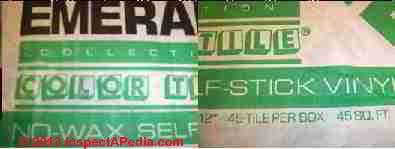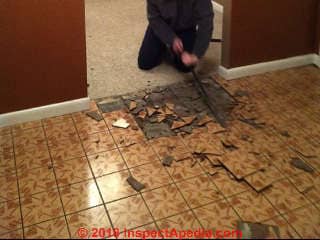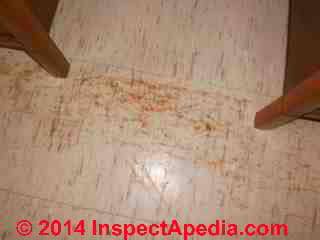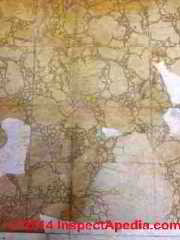 Photos to Identify 1980's Floor Tiles That May Contain Asbestos
Photos to Identify 1980's Floor Tiles That May Contain Asbestos
Photo Gallery of 1980's Era Flooring ID Requests
- POST a QUESTION or COMMENT about how to identify asbestos-containing flooring materials and what to do when asbestos-containing floor tiles or sheet flooring are found in a building.
Photo ID guide to reader-submitted 1980's Asbestos-Containing floor tiles:
This article provides photographs of 1980's floor tiles & flooring identification requests to help identify flooring that contains asbestos.
This article series includes a photo-gallery of pictures of floor coverings submitted for identification along with comments on findings, recommendations, & asbestos content. Readers can use our page bottom COMMENT BOXto submit photos of flooring to get help in identifying floor tiles or sheet flooring that might contain asbestos.
InspectAPedia tolerates no conflicts of interest. We have no relationship with advertisers, products, or services discussed at this website.
- Daniel Friedman, Publisher/Editor/Author - See WHO ARE WE?
1980's Floor Tile or Sheet Flooring Identification Requests
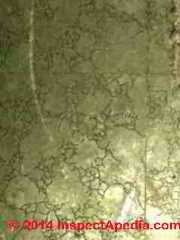 This article contains flooring identification requests for floor tiles or sheet flooring believed to date from the 1980's.
This article contains flooring identification requests for floor tiles or sheet flooring believed to date from the 1980's.
For a 1980's vintage asbestos-containing floor tile photo guide and for a guide to non-asbestos flooring from the later 1980's,
please also see these articles:
- 1980-1988 ARMSTRONG EXCELON VINYL ASBESTOS FLOOR TILES, Patterns & Color Guide
includes 1982 & later ARMSTRONG SELF-ADHESIVE Floor Tiles & AMERICAN BILTRITE Asbestos-Containing Peel and Stick Flooring from early 1980's - 1989 & LATER ARMSTRONG ACCOFLEX FLOORING & TILES
or see our complete list of flooring identification photo guides
at FLOOR TILE / SHEET FLOORING PHOTO GUIDES
Question: I'm worried that this 1980s vinyl sheet flooring contains asbestos
I'm going to take this tile in to be tested, but freaking out this weekend b/c it is peeling in my laundry room and I did tear some of it out awhile ago.
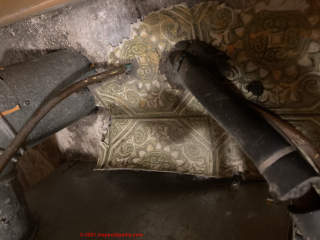 My condo was built in 1980. I don't know what this floor is or when it was manufactured, or by whom.
My condo was built in 1980. I don't know what this floor is or when it was manufactured, or by whom.
My condo was built in 1980. So they probably used supplies made in the 1970s or 1980 at latest. I read on your site to presume asbestos before 1986, which is why I just got my popcorn ceiling tested (it was placed in the bathroom and is crumbling badly due to moisture, so yeah, that's bad).
The flooring I'm worried about is sheet flooring, not individual tiles.
It is in the kitchen and utility room. It is covered in the kitchen by another floor, so no problem there if not disturbed. But it is curling and displaced by the furnace, where there was water coming in due to the flue (condo's fault, I'm going to ask them to help me repair).
Photo attached of curling.
I looked through your photos from sheet vinyl. The closet one I could find that was similar was by Amitco:
https://inspectapedia.com/hazmat/Asbestos_Peel_Stick_Floor.php
But it's not exactly the same.
I saved some of the tiles I pulled up earlier in a bag, but that was awhile ago.
I wonder if I have to take up "fresh" tile for a sample?
I'm not sure how much glue is on the tile. there is mold due to the water issue in the utility room, I wonder if that could confuse the results.
Thank you so much. - Anonymous by private email 2021/05/22
Moderator reply: FIRST: fight that panic over Asbestos
Thank you for the asbestos-suspect flooring question.
FIRST: fight that panic. Worrying about asbestos from flooring, which is basically not-friable (not so easy to make much airborne dust from it): the worry may be a worse health hazard than the asbestos. Only if you're creating a dusty mess is there a substantial risk.
No, you don't need a "fresh" sample - any sample can be tested for asbestos; keep in mind that if the floor was glued-down, the adhesive mastic may also contain asbestos - again, not particularly friable.
No one can assess an asbestos hazard by text alone, but if the amount of broken-up tile is small you'd simply toss out the pieces, damp wipe, HEPA vacuum, and seal the area after of course fixing the water entry source.
About identifying this 1980s vinyl sheet flooring
Because popular floor patterns were made by more than one manufacturer, and because popular flooring patterns were produced across and past years when asbestos was a common ingredient, one cannot safely say, on a photo alone, whether or not a particular floor tile or sheet flooring pattern contains asbestos.
Short of having a sample of the flooring tested, you can make a reasonable *guess* at whether or not your floor contains asbestos by answering the few easy questions found at
DOES THIS FLOORING CONTAIN ASBESTOS? - 5 easy steps that can help you make a reasonable guess at whether or not the floor you ask about contains asbestos.
At the very least, if you can establish the date that the flooring was made or installed then, depending on the country where the flooring was made (and usually where it's installed) you can know if it's an asbestos-candidate.
If that leaves you with suggestions or questions do let me know.
As you may have seen, you can often find a match in the ID-library of asbestos flooring beginning
at ASBESTOS FLOOR TILE IDENTIFICATION - (floor tiles)
If your floor isn't tile but sheet flooring you might also want to see
at RESILIENT SHEET FLOORING ID GUIDE - (sheet flooring)
organized by year and manufacturer where there are similar floor coverings.
There are so many factories and floor tile patterns, types, sizes, and colors over many decades that just looking through catalogs organized by even color or pattern can daunting task.
One can narrow the question by a reasonable guess about the age of the flooring.
At the very least, narrow the search by the age of the building.
You can narrow the guess further if you know when a building was renovated, or by observing the type of tile adhesive or mastic used.
The floor tile dimensions and thickness are also useful.
With that data you can choose among our floor tile or sheet flooring photo ID guides that are organized by year beginning at the link I gave above.
In any event I agree that there are so many manufacturers and floor tile patterns, types, sizes, and colors over many years that they just look through catalogs organized by even color or pattern can daunting task. So you could skip straight to this advice:
ADVICE: For buildings with floor tiles that could be assumed to have been installed in North America before 1986 it would be prudent to treat the flooring as "PACM" or "Presumed Asbestos Containing Material".
The presence of known asbestos-containing flooring does not mean we should panic nor that we should undertake an expensive and dangerous asbestos removal project.
Asbestos is safe and legal to remain in homes or public buildings as long as the asbestos materials are in good condition and the asbestos can not be released into the air.
Generally the safest approach is to leave such flooring alone and to cover it with a coating or with another layer of flooring.
On any of our asbestos-related InspectApedia pages, at More Reding you will find
a complete ARTICLE INDEX to ASBESTOS HAZARDS
to treat your floor most-safely, especially if testing confirms that it contains asbestos, see
ASBESTOS FLOORING HAZARD REDUCTION
and if the floor must be removed (not recommended) see
ASBESTOS FLOORING REMOVAL GUIDE
IF you are faced with a requirement for demolition and if you are uncertain about the flooring's asbestos content and can not identify it through our guides, then you have a sample tested.
We would have much appreciated hearing any comments, criticize, suggestions, or further questions that you may have taken after you've taken a look at the articles I've cited.
InspectAPedia is an independent publisher of building, environmental, and forensic inspection, diagnosis, and repair information provided free to the public - we have no business or financial connection with any manufacturer or service provider discussed at our website. We do not sell products nor services.
We are dedicated to making our information as accurate, complete, useful, and unbiased as possible: we very much welcome critique, questions, or content suggestions for our web articles. Working together and exchanging information makes us better informed than any individual can be working alone.
A brief summary about InspectAPedia . com can be read at ABOUT Inspect A pedia.com https://inspectapedia.com/Admin/About_InspectApedia.php
Best wishes, and thank you again for contacting us.
Reader follow-up: floor contains 80% asbestos, I'm in "meltdown mode"
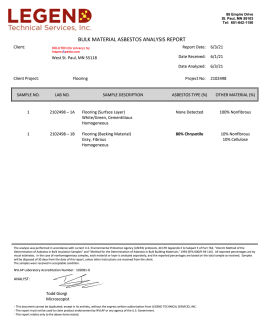 I talked to a local asbestos referral today and he directed me to a lab that's close to me and respected. I'll report back their findings -- thank you so much.
I talked to a local asbestos referral today and he directed me to a lab that's close to me and respected. I'll report back their findings -- thank you so much.
...
I just got the results back on my 1980 sheet vinyl flooring-- asbestos in the backinig. I am in meltdown mode as I try to figure out what's next. The flooring (sheet vinyl) has been disturbed and is curling/peeling/open. I have called my insurance and my condo's insurance and am about to try and cover it up somehow.
[Click to enlarge any image]
Moderator reply: DO NOT PANIC nor melt-down - doing that is by itself bad for your health.
Thank you for the followup as that will be helpful to other of our readers.
80% means that your lab is one of the more-honest ones. I'm dismayed at labs who never report "no asbestos detected" or "less than 0.2% asbestos" out of fear of litigation.
DO NOT PANIC nor melt-down - doing that is by itself bad for your health.
Asbestos is not radioactive. It won't hurt you simply by being nearby.
The hazard, if one occurs, is when the material is so damaged by demolition that you create a dusty mess. Even a bit of peeling isn't alone releasing a lot of asbestos, and possibly not even a detectable level of airborne fibres.
Take a look at the dust control, removal, and hazard reduction advice links I gave you before.
Best approach: leave it in place and put down another layer of sheet flooring overtop.
Question: does this early 1980's Peel-and-Stick Floor Tile have an Asbestos Risk?
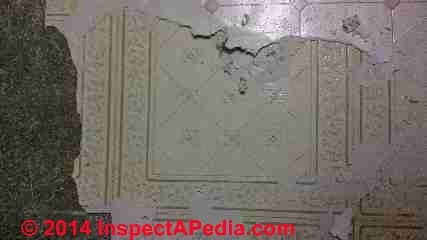 We are renovating our basement when we ran into these peel and stick tiles. The home was built in the early 70's, but the basement looks like was finished in the 80s.
We are renovating our basement when we ran into these peel and stick tiles. The home was built in the early 70's, but the basement looks like was finished in the 80s.
[Click to enlarge any image]
We tried to peel up a tile to see if we could get a manufacturer, but we're unsuccessful as the tile kept breaking up. There are no spare tiles either.
The floor tiles were glued to the cement floor in the basement with a clear glue. In some areas, water had decayed the tile and it has turned to a white chalk and crumbles. I searched thru the library but did not find anything close to what we have.
Any help would be greatly appreciated. - R.R. 1/14/2014
Reply:
While asbestos-containing flooring production in the U.S. pretty much ended in the early 1980's, I have indeed had reports of asbestos-containing floor tiles or sheet flooring installed a few years after that time, probably by installers using new old-stock flooring materials.
Therefore for the flooring in your photo above, and even assuming it was installed in the 1980's, it is not safe to assume the floor is asbestos free.
Given the appearance of the flooring you describe, it would be prudent to treat it as presumed to contain asbestos.
The article ASBESTOS FLOORING REMOVAL GUIDE should help.
If you are unable to leave the material in place and just install flooring over it - that is if it must be removed, you'll want to follow the expert suggestions for avoiding creating a dusty mess. If that means hiring someone and facing a big cost, it might be worth the cost of sending a sample to a certified asbestos test lab. (Typically that costs about $50. U.S.)
Watch out: depending on its age, the sheet flooring installed atop the peel-and-stick floor tiles in your photo could also contain asbestos in its backer/liner.
Also I see a black surface beneath the peel-and-stick floor. What's that? Some older felt papers contained asbestos as did some black floor tile mastics.
See MASTIC, CUTBACK ADHESIVE, FLASHING CEMENT ASBESTOS.
Question: does this floor tile installed sometime between 1965 and 1988 contain asbestos?
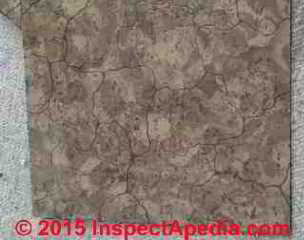 27 June 2015 RR wrote:
27 June 2015 RR wrote:
Hello, I was on your website for sometime trying to match a picture of tile I found under my basement carpet with any picture provided on your site. I was unable to find a matching picture in any of the guides from 1965 to 1988.
Would you please take a look at the enclosed photo and let me know if this tile may have asbestos. We are deciding if we should rip out the tiles before new carpet or just cover them.
[Click to enlarge any image]
Thank you, R.R. 27 June 2015
I have not seen this specific tile pattern either. If you like I'll post it for comment - you'd remain anonymous unless you ask to have contact information included.
If you know the year of installation that'd be helpful.
Reader follow-up:
... it is of no surprise that this is an unknown pattern. We have no idea when this was put down or from where.
Yes, please post it for comment. I need it gone & need to know which method I need to use.
Reply:
It would be prudent to treat the tile as PACM - presumed asbestos containing material. If you face significant demolition costs - for example if you cannot remove the tile without creating dust and mess, then it would be worth having a sample tested for asbestos. The cost is typically about $50. U.S.
If you test the tile let us know the result as that will assist other readers who may have this same pattern installed.
Also see this similar Armstrong Polished Marble vinyl asbestos tile photo found
at 1960-1969 ARMSTRONG EXCELON FLOOR TILE GUIDE: VINYL PLASTIC ASBESTOS
On 2019-12-02 - by (mod) -
Depending on country of installation, age of building, age of flooring, yes that pattern of flooring may be an asbestos-containing product.
You will find guidance on asbestos floor hazard reduction or floor removal in the ARTICLE INDEX found above.
On 2019-12-02 by Sarah
Here is another image of the floor before I ripped and scraped most of it up.
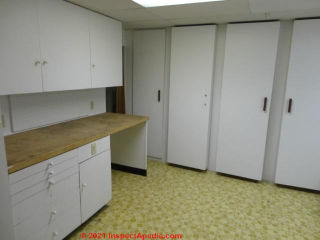
On 2019-12-02 by Sarah
I don't know the age of this flooring, and didnt know asbestos was a possibility when I started removing it. Some came up easily but some was/is stuck to the floor and I have been scraping (sometimes soaking first). Do you know this pattern?
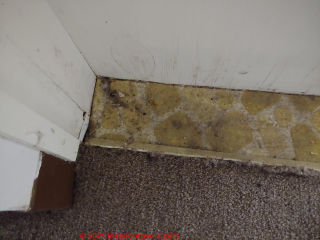
On 2019-07-23 - by (mod) -
Bob
What a stunning and in my OPINION incorrect remark.
None of the flooring is "tar based" though speaking loosely, older asbestos-containing floor was asphalt based - some folks may confuse asphalt with tar as asphalt does in fact contain tar among its ingredients - and its black.
I would be most grateful if your floor contractor can let us know where his or her opinon came from. A scholarly study, government report, survey, or just speculation.
In my experience, in North America, and IF we restrict the conversation to "resilient" floor tile (asphalt asbestos floor tiles and vinyl asbestos floor tiles) most of those floors contained asbestos.
A place to start is at https://inspectapedia.com/hazmat/Vinyl_Asbestos_Tile_Brands.php
On 2019-07-23 by Bob G
Hi, I just had a floor contractor tell me that only 15% of all the floor tiles down from 1965 - 1988 have asbestos ...... 85% are tar based material ? doesn't sound right , im having mine tested anyway.
Is that statement correct ? seems low to me .
Thanks Bob
On 2018-12-22 - by (mod) -
Dan you're showing ceramic tile, not vinyl asbestos or asphalt asbestos flooring.
If the house was built after around 1985 there's little chance that it used asbestos products in any case.
In the search box on this page search for ASBESTOS IN CERAMIC TILES for more details.
On 2018-12-21 by Dan
Hello I didn’t know anything about this subject. I’m concerned after reading. But are you able to tell from these photos what a house from the 80’s in New Jersey USA Cherryhill 08003.
IMAGE LOST by older version of Clark Van Oyen’s Comments Box code - now fixed. Please re-post the image if you can. Sorry. Mod
On 2018-03-19 - by (mod) -
Aio
You don't give the country, city, state or province of the home, so with no other information and given the age and appearance of the flooring it would be prudent to treat it as presumed to contain abestos.
The amount of damage and material release from removing carpet tack strips on an otherwise intact vinyl or asphalt asbestos tile floor should normally be trivial and easily cleaned using damp wiping and HEPA vacuuming.
On 2018-03-19 by Aio Zabala
We found the original tiles after removing carpets. The tiles are 25x25cm, which do not seem to correspond the dimensions of tiles said to have asbestos in the 1980s. The house was built in 1981 or 82 by Anglia Barratt. The tiles are in good condition, but were altered in the perimeter of the room in order to remove the thin wood battens nailed to the floor, that were holding the carpet.
Any idea of whether this could contain asbestos?
IMAGE LOST by older version of Clark Van Oyen’s Comments Box code - now fixed. Please re-post the image if you can. Sorry. Mod
Question: does this early 1980's Peel-and-Stick Floor Tile have an Asbestos Risk?
We are renovating our basement when we ran into these peel and stick tiles.
 The home was built in the early 70's, but the basement looks like was finished in the 80s.
The home was built in the early 70's, but the basement looks like was finished in the 80s.
[Click to enlarge any image]
We tried to peel up a tile to see if we could get a manufacturer, but we're unsuccessful as the tile kept breaking up.
There are no spare tiles either. The floor tiles were glued to the cement floor in the basement with a clear glue. In some areas, water had decayed the tile and it has turned to a white chalk and crumbles.
I searched thru the library but did not find anything close to what we have.
Any help would be greatly appreciated. - R.R. 1/14/2014
Reply:
While asbestos-containing flooring production in the U.S. pretty much ended in the early 1980's, I have indeed had reports of asbestos-containing floor tiles or sheet flooring installed a few years after that time, probably by installers using new old-stock flooring materials.
Therefore for the flooring in your photo above, and even assuming it was installed in the 1980's, it is not safe to assume the floor is asbestos free.
Given the appearance of the flooring you describe, it would be prudent to treat it as presumed to contain asbestos.
The article ASBESTOS FLOORING REMOVAL GUIDE should help.
If you are unable to leave the material in place and just install flooring over it - that is if it must be removed, you'll want to follow the expert suggestions for avoiding creating a dusty mess.
If that means hiring someone and facing a big cost, it might be worth the cost of sending a sample to a certified asbestos test lab. (Typically that costs about $50. U.S.)
Watch out: depending on its age, the sheet flooring installed atop the peel-and-stick floor tiles in your photo could also contain asbestos in its backer/liner.
Also I see a black surface beneath the peel-and-stick floor. What's that? Some older felt papers contained asbestos as did some black floor tile mastics.
See MASTIC, CUTBACK ADHESIVE, FLASHING CEMENT ASBESTOS.
Question: does this floor tile installed sometime between 1965 and 1988 contain asbestos?
Hello, I was on your website for sometime trying to match a picture of tile I found under my basement carpet with any picture provided on your site. I was unable to find a matching picture in any of the guides from 1965 to 1988.
Would you please take a look at the enclosed photo and let me know if this tile may have asbestos. We are deciding if we should rip out the tiles before new carpet or just cover them.
[Click to enlarge any image]
Thank you, R.R. 27 June 2015
I have not seen this specific tile pattern either. If you like I'll post it for comment - you'd remain anonymous unless you ask to have contact information included.
If you know the year of installation that'd be helpful.
Reader follow-up:
... it is of no surprise that this is an unknown pattern. We have no idea when this was put down or from where.
Yes, please post it for comment. I need it gone & need to know which method I need to use.
Reply:
It would be prudent to treat the tile as PACM - presumed asbestos containing material. If you face significant demolition costs - for example if you cannot remove the tile without creating dust and mess, then it would be worth having a sample tested for asbestos. The cost is typically about $50. U.S.
If you test the tile let us know the result as that will assist other readers who may have this same pattern installed.
Also see this similar Armstrong Polished Marble vinyl asbestos tile photo found at 1960-1969 ARMSTRONG EXCELON FLOOR TILE GUIDE: VINYL PLASTIC ASBESTOS
Question: do these self-stick Emerald Brand vinyl floor tiles contain asbestos?
Can you tell if this tile has Asbestos - I also have photos of the box.
Reply: Trademark Supplies floor tiles - modern version should not contain asbestos
Possibly yes; some self-adhesive floor tiles contained asbestos in the tile backer.
But without matching the floor tile to a known-asbestos-containing photo index one cannot say for sure without performing a lab test for asbestos content.
Often such testing is unnecessary or even inappropriate, depending on the age, location, and condition of the flooring.
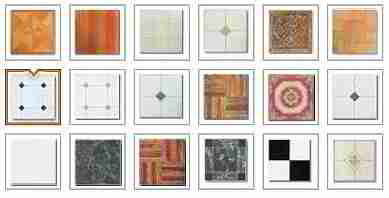 The Emerald vinyl "stick-on" floor tiles in your photograph are produced by Trademark Supplies - a company that seems to exist only on and at Amazon.com.
The Emerald vinyl "stick-on" floor tiles in your photograph are produced by Trademark Supplies - a company that seems to exist only on and at Amazon.com.
These tiles (see the red marked tile center row left end) are currently available from Amazon.com and are identified as 12X12 Vinyl Stick-On Tiles With Four Emerald Diamonds Self Adhesive Flooring RT4022
At least in that version it would be a surprise if a current for-sale floor product contained asbestos.
Can you
- tell me the age of the building and flooring?
- send me photos of all of the information on the tile box from all sides, including model and lot numbers?
Details about identifying older installations of sheet flooring or sheet-forms of resilient flooring that may contain asbestos are now found
at RESILIENT SHEET FLOORING ID GUIDE
Reader Question: do these inset pattern floor tiles contain asbestos?
We were hoping you could take a look at this image fo determine if it contains asbestos? The house was built around 1970, but we arent sure if this is the original tile. Thank you, J.S. 2/11/2014
Reply:
H.S., no one can say for sure what a material contains from just a photo, but the image indeed looks like a 1960's vintage asphalt or vinyl asbestos floor installation, possibly a Kentile floor as those used many pattern inserts.
Watch out: It looks as if the breakup is making a dusty mess - something to be avoided in any case. Stirring up dust from an aggressive asbestos-suspect floor removal creates a health hazard for workers and for building occupants.
I would stop working in the manner shown in the photo. I cut off the worker's head in this photo, not as a punishment but for privacy. But in addition to breaking up this flooring in a dusty manner we see no dust containment methods, and no personal protection gear.
Identify this Bahamas-installed flooring as asbestos-containing?
I am disabled and living in the Bahamas. The house I am renting has old Vinyl floor tiles. If I may have just a few questions about the tile floor and asbestos.
Please can you advise me -
(i) whether the tiles in the attached photos are Armstrong Asbestos tiles?
(ii) where can I get the tiles tested this week to see if they have asbestos?
(iii) can they be properly sealed with ceramic tile over the top as I understand safe asbestos removal will be very expensive and my landlord will likely not pay for that. (this is the Bahamas...!)
(iv) Lastly, how much do you charge low income individuals for a house inspection...?
I would be extremely grateful if you can get back to me quickly as I need to decide if I am staying or leaving.
with warm regards and thanks, R.H. 11/4/13
Reply:
Some of the photos look like some of my Armstrong tile photos - the latter ones, darker and blurry are more uncertain - they look a bit like Kentiles.
ASBESTOS TESTING LAB LIST (in the More Reading linnks below) has help in finding a certified lab.
Reader follow-up:
We are getting the samples sent to the lab by courier for testing today.
If they are the Armstrong or Kentiles are those ASBESTOS tiles?
And lastly as they are cracking and curling up at the edges in several places on the floor does that mean I must address this? Sometimes I smell a chlorine type smell and have a very dry throat. My friend who is visiting has been coughing too.
Reply:
Sorry I was not more clear;
If these floor tiles date from before the early 1980's (or older) they probably contain asbestos.
Reader Question: is this flooring 51202 Caliqua by Armstrong® ?
Hello, is the attached vinyl tile the 51202 Caliqua (embossed or embossed veining) or the 51203 Trajan embossed? Thanks. - J.S. 10/22/2014
[Photo at above left]
Reply: Probably Excelon Polished Marble floor tiles - see Peruvian Beige #54192
I don't think so, J.S., though your flooring is very similar and is a pattern I've seen before. I'm posting it here pending a certain name identification. For comparison of three similar flooring patterns see
- Custom Dianna White Caligula 12" x 12" x 1/16" Embossed 51202
- Custom Dianna White Trajan 12" x 12" x 1/16" 51203
- Excelon Polished Marble, embossed 12" x 12" x 1/16" Peruvian Beige 54192 - this one looks closer to your floor.
At the right of your photo above I include a very similar photo of this flooring provided by another reader.
The three example floors I cite are described across a wide number of years of Armstrong flooring products and are cited here from
1973 - ARMSTRONG EXCELON VINYL ASBESTOS FLOOR TILES Complete Pattern & Color Guide, 9x9 & 12x12-inch
What to Do About Unidentified Flooring that May Contain Asbestos
If you are facing a costly demolition then it would make sense to confirm asbestos content using
a certified asbesto test lab - ASBESTOS TESTING LAB LIST
Else it makes sense to treat the material as "Presumed Asbestos Containing Material" or "PACM" flooring based on its age and appearance.
...
Reader Comments, Questions & Answers About The Article Above
Below you will find questions and answers previously posted on this page at its page bottom reader comment box.
Reader Q&A - also see RECOMMENDED ARTICLES & FAQs
Question: Possible asbestos-containing floor tiles in a school, questions about proper handling
Hi. I have a question about asbestos in floor tile and its removal. I work at a public school and the school had a contractor come in to remove some flooring that was starting to "buckle up" in some areas due to water seeping underneath it. When the contractor came I happened to be around and I asked him before he started if the tile could be asbestos (the school was built in 1952).
He looked at it and said it wasn't 9x9 inch, and he wasn't sure what was underneath it yet, so he couldn't say for sure. When I started at the school I was made aware by my boss that there is asbestos tile underneath the carpet in the classrooms, but he didn't mention the hallways, where this work was going to be done.
I kept a watch on the contractors as they were removing the tile flooring, (I stayed a safe distance from them...like outside the building through a window). I noticed they used no masks and there was no plastic barriers put up inside the building. They were breaking the tile up though because I noticed them shoveling it up and putting it in the big 55 gallon plastic barrels used for garbage.
They stayed for about 2 days doing this. When they were done they left these filled barrels of the tile for us to dump! I didn't want to be involved at all in their dumping! My boss came though and he said he needed my help in dumping the barrels in the outside container for garbage. I REALLY wanted nothing to do with this and I panicked inside. I was afraid though to ask about its safety. When we went outside to dump them I kept my distance as much as possible.
When we dumped the first barrel I held my breath and we dumped it quickly and a HUGE bunch of dust went into the air. I stepped far away and let the dust clear. I then asked if he had any kind of face mask. He did, but only the N95 kind. I put two on and some goggles. We then dumped the rest. My question is, what are the chances that the flooring contained asbestos, and if it did, wouldn't the contractor and our head supervisor that ordered the work know about the flooring? - Mike 8/22/11
Reply:
Mike
No one can say just from text whether or not the floor tile that was taken up contained asbestos, though the lack of dust control and personal protection sounds to me like an amateur was doing the job. Even non-asbestos-containing dust can be hazardous, especially at acute exposure levels.
From the age of the school (1952) some asbestos containing materials would be expected to be present in lots of items, especially floor tiles. And the contractor's assertion that only 9" floor tiles contain asbestos is incorrect.
- ask your doctor for an opinion about your health and exposure to demolition dust that might have contained asbestos and any respiratory health complaints you may have
- if there is remaining dust or remaining examples of the same flooring they can be tested for asbestos
- building management can make be sure all of the demolition dust has been properly cleaned and removed - if it's asbestos-containing, a higher level of cleaning and post-cleanup testing are needed.
- Don't do more demolition without a competent risk assessment
And for your question of whether or not the contractor would or would not know if the floor contained asbestos?
My OPINION (not a lawyer) is that the contractor is legally obligated to be competent to perform the work for which s/he is hired; at a school, and removing flooring, that should include the ability to recognize a "red flag" that would stop the job until an asbestos hazard assessment has been made by a professional.
Faced with very high costs of an asbestos cleanup, and worried about causing a (perhaps inappropriate) panic among parents of school children, building managers I've met have sometimes opted for an "ignorance is bliss" argument.
At a large Jewish Community Center in New York where it was patently obvious that there was asbestos-containing pipe insulation and flooring, the building management showed me a "report" asserting that the building was "asbestos free". The report authors simply stayed out of building areas where asbestos found.
Question: floor tiles below asbestos in a 1950's house may contain asbestos
I was pulling up some carpet in my basement today and found that there is tile on the floor beneath it. That didn't seem like a problem to me except in one corner the tile came up with the carpet and there is a green tile beneath that. The house was built in 1950. should I be concerned that the green tile has asbesto in it?
The tile broke into pieces. - Don Mac 9/5/11
Reply:
Don from the age of materials you describe it's a good chance you have one or more layers of asbestos containing floor tiles, though of course I can only speculate with so little information.
However if the floor is covered with additional layers of tile or even carpeting, it's unlikely that it is being disturbed enough to produce a detectable level of asbestos (from that source) in the building air or dust.
A single piece or two of broken tiles are not measurable; what you want to avoid is demolition making a big dusty mess.
Search our site for "How to Reduce the Hazard Floor Tiles That May Contain Asbestos" or "ASBESTOS FLOORING HAZARD REDUCTION" to read about procedures for handling the flooring.
Question: How can I identify various other brands and product numbers of floor tiles that might contain asbestos?
Do you know if the SEARS brand HOMART 64-7169 asphalt floor tile contained asbestos? - Paul Wright 9/22/11
Have you heard of Dura Floor Plastic Asphalt Tiles? Do they contain asbestos? - Jo Lynn Judka 10/24/11
I have 12" x 12" tile in the basement just like the pattern San Roque Gold 57161 from 1980.
However, this tile is not 1/8 thick but 1/16 and it was peel & stick. Would this contain asbestos? - David 11/27/11
Is there a way I can forward someone a photo of a school floor to determine if it contains asbestos? I am unable to get back into the building It is closed, but the school dept wants to open it again and is saying that there isn't a problem. I looked through the tiles on your site, but couldn't find an exact match. The school was built in 1950-1960, but we have no evidence that the tiles have been replaced. Can you help? -
we have an armstrong floor tile (black color) with the following numbers on the back L4 1230 021898. We don't know the year it was installed. Does it contain asbestos? Is there a way to cross reference these numbers? - Dan 5/1/12
We have the San Roque pattern sheet vinyl. Did Armstrong use the same patterns at a later date for their sheet vinyl but without asbestos? We have already started to remove it and I am concerned. - Sue 10/24/2012
We have vinyl sheet flooring that was put in about mid 1984. Is this anything to worry about? When exactly was asbestos banned in the manufacture of sheet flooring? - Peter 11/6/2012
Reply:
David, naturally by email alone no one can say with certainty whether or not a floor tile contains asbestos, but if your flooring matches one of the ACM floor tiles we illustrate here, AND if you are confident about the age (as you suggest) most likely it is an asbestos-containing product. And yes, for sure there were some peel-and-stick floor tiles that contained asbestos in the tile baking.
That does not necessarily mean that you need a costly asbestos remediation job - it depends on the condition of the surface, use made of the area, etc. If the floor is sound you may have the option of simply covering it with a new material.
JoLynn, sorry we don't have information about DuraFloor plastic asphalt tiles. Do you know the age of the product? You're welcome to send us photos (see the CONTACT link at top, side, bottom of our pages), and I'll research further. Certainly up to the early 1980's many asphalt floor tile products contained asbestos.
Dan, while we have published product and lot numbers for some floor tile products, there are just too many of them, thousands. Unlike mechanical equipment like water heaters or furnaces, I have not found a standard of correlation between product numbers and date of manufacture, though it probably was included in widely varying ways by individual manufacturers.
You can narrow down the asbestos question by:
- noting the age of the building itself as that sets the earliest plausible date for its floor materials +/- a year or so to allow for flooring sold from stock
- noting the date of any renovations of the building
- noting whether or not there are multiple layers of flooring or other similar changes that give a renovation history
- noting information on any packaging used for the floor tiles - sometimes an extra box of floor tiles is left and stored in a building, intended to supply future repairs or changes to the floor
- comparing the appearance of your flooring to the photographs we provide in these tile identification articles
- sending a small sample of flooring to a certified asbestos testing lab
For a tile floor of unknown constituents, do not do something foolish such as grinding, sanding, power sawing, or a dusty messy demolition.
Peter,
I think you mngh want to ask Armstrong, but in NY case, if you remove materials following the recommended procedures and avoid making a dusty ness you should be OK
Question: dealing with unknown floor tiles
I purchased a co-op built in the 1950's. I need to put down a new floor. The last layer of flooring is green 9x9 vinyl tiles. The pattern looks close to seneca white but the background is light green with dark green pattern. There is black tarry stuff underneath. The tiles are extremely thin. I ripped out the tiles and the plywood underneath them in the corner about 18" square.
The super told me to leave it alone as it might be asbestos, but all the contractors who have seen them, seem not to be worried about ripping up the tiles. I would feel better to play it safe and just floor over them. How do I e-mail a picture to you? - Jeanie in Queens NY 11/13/2011
I have a early 60's home with both bathrooms having what appears to be a solid surface material poured over a greenish felt. The flooring is tan with colored flecks in it throughout. I have looked for the material but haven't found any info. Does anyone know what it is? Is it possible that this material contains asbestos? - Dan 1/10/12
the tile in the place I work appears to be asbestos tile. there are some squares that are damaged, and appear to be chipped out. there are small particles, chunks, etc. in the place where the tiles are missing. is this a danger to us? - Lynn 1/12/12
I want to renovate this ranch soon and am not sure what the tile is and who do I call? I want to renovate this ranch soon and am not sure what the tile is and who do I call?Ceiling tile is from 1940 - Jo 2/7/2012
I have an old ranch home w/ sheet lino.x2 layers, over OSB board, over another type of flooring over old hardwood. From what I can see so far. The hardwood has blunt square ends, and is about 3-4" wide and appears to have paint on it. I know there is some rot in that area and would need replacing from reclaimed wood. My question is what is the best way to remove all the lino and OSB and floor below that to get to the hardwood? I know it's going to be labor intensive but not sure how to go about it. - Tracey 2/13/2012
Utility room floor installed 1971 is Armstrong Excelon vinyl asbestos place and press tiles. Some of the tiles are loose. they are whole..just loose. Please recommend what glue to use to re-install them. - Anne 2/13/2012
I work at a Petland Discounts location that's over 20 years old. I've gotten severe breathing problems at this store. The floor polishing company comes in and polishes the floor every month and there is this thick dust in the air and then it gets all over the products. I am concerned that it contains asbestos. There are also many broken tiles in the store. - Despina 5/22/2012
In my kitchen we have a sub floor, then asbestos tiles, then another sub floor and then a layer of linoleum flooring down. We want to lay another floor down but our floor is already up an inch with everything on it. We want to removed the whole flooring but have no clue how we should go about doing this without getting the asbestos in the air. It is also laid in our hallway and our whole basement. Thank you so much for any help you can provide. - Gigi - 6/11/2012
I was going to put new ceramic tiles in the kitchen floor, but when I removed the transition between the wood floor and ceramic tiles I saw vinyl tiles under the kitchen floor. My question is how I would know that the vinyl tiles are asbestos or not? - Mike 7/10/2012
i removed floor tiles by hand that look very similar to some of the ones you have pictured on your web site about 9 years ago.
basically i used an old grill spatula to peel them up off of the cement floor. i did use a dust mask but i was unaware at the time that some older floor tiles contain asbestos. do i have anything to worry about? - Joe 8/1/2012
Hello I scraped up a tile floor in my house and I now fear that it was asbestos. The backing is black not white. It did not grind to dust, but it came off in pieces. The floor is covered in the black backing still and I don't know how I should remove this. Should I be concerned about removing this part? Also I suspect these tiles continue into another room under a rug. I would like to remove them eventually if possible. What do you recommend? - Mandy 10/29/2012
My husband and his family were doing some remodeling on a home we just bought (built in the 1930's). When I stopped by the house i saw that they had ripped out the old flooring in the kitchen and bathroom. Underneath the old carpet and flooring were 9x9 squares that were on top of the original hardwoods. I freaked out because i remembered hearing something about 9x9 tiles and asbestos on hgtv.
These squares are black, but they are flexible, almost like a thick paper or a cardboard rather than a hard tile. We aren't sure if it is just some sort of backing, or an asphalt asbestos tile. They had already spent the weekend tearing most of it up and it is all over the place right now. any info/suggestions etc would be very greatly appreciated. - Jennifer 10/29/2012
Reply:
Asbestos-containing flooring in good condition does not have to be removed from a building, and worse, inept removal can create a much greater hazard than leaving most asbestos materials in place.
Asbestos was widely used as a filler in both asphalt-based and some vinyl based floor tiles of varying thicknesses, and extending to some thin, flexible self-adhesive backed tiles as well as some sheet flooring.
See ASBESTOS FLOOR TILE IDENTIFICATION PHOTOS 1949-1959 for an extensive photo guide to asbestos-containing flooring materials.
We recommend taking a look at the suggestions found
at ASBESTOS FLOORING HAZARD REDUCTION
Comment from reader: anonymous:
Hey Joe there's always a "risk" when removing anything that has to do with Asbestos. I understand that you probably didn't take caution at all with the removal and you probably weren't wearing the proper protection. There's two things that could be red flags. 1. I'd be worried if you were a constant to heavy smoker. 2. I'd also be worried if you've done this type of removal many times before or after without protection. The only way to know for certain if true damage has been done is tell your Doctor or care provider about this incident and ask for their advice.
Question: did asbestos flooring come in just tiles or also in roll or sheet flooring?
Can the asbestos flooring come in tiles only or does it come in a role? - P.H. 12/31/12
Reply:
Asbestos-containing flooring was sold in both individual floor tiles and in rolls of sheet flooring. But just as with vinyl or plastic floor tiles, not all flooring contains asbestos.
LINOLEUM & Other Sheet Flooring includes examples of sheet flooring that often did not contain asbestos.
To treat floor coverings in asphalt-based floor tiles or sheet flooring, or vinyl (plastic)-based floor tiles or sheet flooring, it is reasonable to treat flooring sold in the year ranges described in the article above as PACM (Presumed Asbestos Containing Material). Also the mastic or adhesive used to install flooring may also contain asbestos. Keep in mind also that very often it is not necessary nor even recommended to remove PACM floor coverings.
But if conditions require that it be removed,
see ASBESTOS REMOVAL GUIDE, FLOORING.
Question: radon system installation drilled through presumed-asbestos-containing floor tiles: how much of an asbestos hazard has that created?
We had a radon abatement system installed in our basement laundry room before we moved in. During our home inspection, the inspector told us there might be asbestos tiles in the basement. We confirmed this is probably the case, even though there is a new floor down there, because under the hot water heater you can see a reddish tile (you can't tell the size), followed by a layer of concrete, followed by the new vinyl tile (current day).
To install the radon system they drilled a four inch diameter hole through the floor and then another 4 inch hole through the brick and mortar of the wall to the outside. Now I'm concerned about the asbestos that may have been released into the air from the disturbance.
I've been told there wouldn't be a lot of asbestos released into the air from an event like this one because of the small surface area. Is this true? Also, I've been reading that amphibole types of asbestos were used in mortar as well. If it was just chrysotile from the vinyl tile then it would be less concerning than the "worse types" of amphibole asbestos. However, perhaps they also used amphibole types of asbestos in vinyl tiles? Btw, the house was built in 1948. - B.B. 2/07/2013
Reply:
With the reclama that no one can perform an environmental risk assessment by email, in general, the total dust created by a single hole drilling event should be quite small compared with projects involving demolition of a floor.
It is reasonable to treat the flooring as presumed-asbestos-containing material (PACM); as virtually all of the old suspect floor has been covered, in normal use and occupancy the remaining asbestos-exposure risk to occupants is probably beneath detection.
If you wanted to investigate the asbestos dust risk created by drilling a hole for the radon abatement system more scientifically you'd collect what you think is dust left undisturbed from and settled near the area where the work was performed. Send that dust sample to a certified asbestos testing lab and ask them to screen it for you.
You can use the procedure at TEST KITS for DIY MOLD or DUST [Do not send your sample to us.]
Air testing is probably less reliable at this juncture.
Question: is your asbestos floor tile photo library exhaustive, and is the old black floor tile adhesive also a hazard?
I am emailing you after reviewing your very informative website. I have a question about the tile in my basement. We are looking to renovate the space and are concerned about the tile possible containing asbestos. I live in new Jersey and my house was built in 1964. A form of asphalt tile was glued down in either 1964 or 1965. After reviewing your website and the photo section. I do not see our particular tile shown.
My question is: Is your photo gallery all inclusive of tile containing asbestos? The tile can be popped up without breaking any of the tile. Would the adhesive used in laying the tile also contain asbestos? It seems to be a black tar like substance. I would be able to send you a picture of the actual tile if that would be helpful.
- E.T. 4/10/2013
Reply:
E.T.
Thank you - your question is helpful to me too.
No my photo lib of asbestos containing tile is not exhaustive, though it's the largest one that's been published. There are some companies for whom I cannot find a comprehensive catalog showing all of their tile patterns (Armstrong was the most thorough), and there are companies out of the U.S. whose catalog data is even more scarce. But given how these products were made, it's reasonable to treat old asphalt-asbestos and vinyl-asbestos floor tiles of the appropriate age range as "PACM" or presumed-asbestos containing.
Nobody should panic about this flooring - doing so can result in spending inappropriately. But at the same time some caution is in order such as avoiding making a dusty mess by grinding, steel power buffing, and incompetent demolition. As well, in public spaces such as schools additional regulation may apply.
Where the floor is in good condition there are low cost options that help minimize the risk of asbestos release such as hard coatings.
For floors such as the one you describe, where whole tiles pop up, one can remove such tiles with minimal disturbance of the tile itself, thus minimal asbestos dust release.
But you are right to worry about the tile mastic or "glue" that was used: indeed some mastics, particularly the black asphaltic mastic, often contained asbestos. Asbestos fibers (and possibly asbestos dust filler) were widely used in asphalt-based mastics, glues, and in roof flashing cements. The same caveats apply: if you avoid making a dusty mess you will minimize the risk and hazard of asbestos. We have published wetting guidelines and flooring removal guidelines citing expert sources to help minimize risk as well as cost.
If you are facing a costly demolition job then it may be appropriate to have both the mastic and a section of floor tile tested by a certified asbestos testing lab. The cost is usually around $50./sample or less. If you have other specific questions please let me know. Working together makes us both smarter.
Please keep me posted on how things progress, and send along photos of the flooring you described as well as where it's popped up showing the asbestos if you can. Such added details can help us understand what's happening and often permit some useful further comment. What we both learn may help me help someone else. And by publishing a photo of your unidentified floor tile we invite other readers to comment if they know the pattern, age, and manufacturer.
Question: how to post a picture at InspectApedia
(Aug 25, 2014) micky said:
Help! Took off my 5 year old armstrong tile. Started pulling off the next layer not knowing of potential hazards. Found out when researching easiest ways to remove tile as it is harder to get up. Can you help me date this tile pattern?
(how to post picture?)
Oct 1, 2014) Rodney... said:
Can someone please help me with a tile identification?? I would like to know if it looks like it will have asbestos.. My landlord asked me to pull up the carpet and this was below it. I have photos but I do not see a way to attach them to my comment here. I sent a few photos for the general email "contact" here a few days ago... I am sorry for the short notice but I have a city inspector scheduled for Monday
Reply:
Micky, Rodney and others: you can use the email at our CONTACT link to send us some photos of your floor for comment.
Rodney you can use the email found at our CONTACT link but it may not be necessary. If you've got vinyl or asphalt floor tiles installed before the 1980's it would make sense to treat them as presumed to contain asbestos - and to avoid making a dusty demolition, sawing, grinding mess.
Reader Question: How can I Submit a Floor Tile Photo for Identification
(Apr 3, 2014) Anonymous said:
How can I submit a photo of a tile to see if it might contain asbestos?
Reply:
Sure, Anon, just use the email found at our CONTACT link seen at the top or bottom of any InspectApedia.com page - but it may not be necessary.
If you've got vinyl or asphalt floor tiles installed before the early 1980's it would make sense to treat them as presumed to contain asbestos (PACM or "Presumed Asbestos Containing Material") - and to avoid making a dusty demolition, sawing, grinding mess.
...
Continue reading at ASBESTOS FLOOR TILE PHOTO ID REQUESTS - topic home, or select a topic from closely-related articles below, or see our complete INDEX to RELATED ARTICLES
Or see these
Recommended Articles
- ASBESTOS FLOOR TILE PHOTO ID REQUESTS - home
- ASBESTOS FLOOR TILE ID REQUESTS 1950's or EARLIER or Sheet Flooring Identification Requests
- ASBESTOS FLOORING IDENTIFICATION 1950's or LATER in New Zealand
- ASBESTOS FLOORING IDENTIFICATION 1950's or LATER in Puerto Rico
- ASBESTOS FLOORING IDENTIFICATION 1950's or LATER in the U.K. Identification Requests
- ASBESTOS FLOOR TILE ID REQUESTS 1960's or Sheet Flooring Identification Requests
- ASBESTOS FLOOR TILE ID REQUESTS 1970's or Sheet Flooring Identification Requests
- ASBESTOS FLOOR TILE ID REQUESTS 1970's-2
- ASBESTOS FLOOR TILE ID REQUESTS 1980's or LATER or Sheet Flooring Identification Requests
- ASBESTOS FLOORING HAZARD REDUCTION
- ASBESTOS FLOORING IDENTIFICATION
- ASBESTOS FLOORING IDENTIFICATION GUIDE INDEX - all brands, all years
- ASBESTOS FLOORING REMOVAL GUIDE
- ASBESTOS REMOVAL, WETTING GUIDELINES
- ASBESTOS RISK ASSESSMENT
- ASBESTOS TEST RESULTS for TILE & SHEET FLOORING
- ASBESTOS TESTING LAB LIST
- DOES THIS FLOOR CONTAIN ASBESTOS? - 5 easy questions to tell if your FLOOR probably contains asbestos -
- DOES THIS MATERIAL CONTAIN ASBESTOS? - 5 easy questions to tell if a BUILDING MATERIAL probably contains asbestos -
Suggested citation for this web page
ASBESTOS FLOOR TILE ID REQUESTS 1980's or LATER at InspectApedia.com - online encyclopedia of building & environmental inspection, testing, diagnosis, repair, & problem prevention advice.
Or see this
INDEX to RELATED ARTICLES: ARTICLE INDEX to ASBESTOS HAZARDS
Or use the SEARCH BOX found below to Ask a Question or Search InspectApedia
Ask a Question or Search InspectApedia
Try the search box just below, or if you prefer, post a question or comment in the Comments box below and we will respond promptly.
Search the InspectApedia website
Note: appearance of your Comment below may be delayed: if your comment contains an image, photograph, web link, or text that looks to the software as if it might be a web link, your posting will appear after it has been approved by a moderator. Apologies for the delay.
Only one image can be added per comment but you can post as many comments, and therefore images, as you like.
You will not receive a notification when a response to your question has been posted.
Please bookmark this page to make it easy for you to check back for our response.
IF above you see "Comment Form is loading comments..." then COMMENT BOX - countable.ca / bawkbox.com IS NOT WORKING.
In any case you are welcome to send an email directly to us at InspectApedia.com at editor@inspectApedia.com
We'll reply to you directly. Please help us help you by noting, in your email, the URL of the InspectApedia page where you wanted to comment.
Citations & References
In addition to any citations in the article above, a full list is available on request.
- David Grudzinski, Advantage Home Inspections, is a professional home inspector in Cranston, RI. 02910. He can be reached at 401-935-6547, fax- 401-490-0607 or by email to contact/us@advantagehomeinspections.us 04/26/2009
- Thanks to reader R.M. for the photo and test information documenting chrysotile asbestos in a vinyl-asbestos floor tile from a 1969 home. January 2011.
- Thanks to reader Kim for the photo of black and white VAT resembling Armstrong Excelon from a 1952 home - January 2011.
- EVER WEAR TILE CO is currently (2009) in the Terrazzo, Tile, Marble, and Mosaic Work industry in Fallon, NV. 775) 423-6221. [We do not know the company history nor whether there is an association with EverWear vinyl asbestos floor tiles discussed in this article.]
- Thomas Hauswirth, Managing Member of Beacon Fine Home Inspections, LLC and (in 2007) Vice President, Connecticut Association of Home Inspectors Ph. 860-526-3355 Fax 860-526-2942 beaconinspections@sbcglobal.net 06/07: thanks for photographs of transite asbestos heating ducts
- Gary Randolph, Ounce of Prevention Home Inspection, LLC Buffalo, NY, for attentive reading and editing suggestions. Mr. Randolph can be reached in Buffalo, NY, at (716) 636-3865 or email: gary@ouncehome.com 3/07
- "Asbestos in your home or at work," Forsyth County Environmental Affairs Department, Winston-Salem NC 12/08
- "Asbestos Floor Tile Removal", the University of Minnesota's advice on removing VAT (vinyl asbestos or asphalt asbestos floor tile) can be read in detail at www.health.state.mn.us/divs/eh/asbestos/floortile/index.html
- EPA, ASBESTOS IN YOUR HOME [PDF] - U.S. EPA, Exposure Evaluation Division, Office of Toxic Substances, Office of Pesticides and Toxic Substances, U.S. Environmental Protection Agency, Washington,D.C. 20460
- Resilient Floor Covering Institute, 1030 15th St. NW, suite 350, Washington D.C.
- ASBESTOS REGULATIONS FOR SCHOOLS (the Asbestos Hazard Emergency Response Act, "AHERA") [PDF] (96 pp, 589k), web search 08/17/2010, original source: http://www.epa.gov/asbestos/pubs/2003pt763.pdf,
- Asbestos Regulations: State asbestos regulatory agencies (5 pp, 17k) (original source http://www.epa.gov/asbestos/pubs/statecontactsapril2009.pdf ) for information on how to find an accredited asbestos professional.
- EPA Guidance for Controlling Asbestos-Containing Materials in buildings, NIAST, National Institute on Abatement Sciences & Technology, [republishing EPA public documents] 1985 ed., Exposure Evaluation Division, Office of Toxic Substances, Office of Pesticides and Toxic Substances, U.S. Environmental Protection Agency, Washington,D.C. 20460
- The ABCs of Asbestos in Schools (August 2003), U.S. EPA, Web search 08/17/2010, original source: http://www.epa.gov/asbestos/pubs/abcsfinal.pdf - aqui se encuenta la misma documenta escrito en Espan~ol: El ABC del Asbestos en las Escuelas, copy on file as /sickhouse/EPA_Asbestos_ABCs_Schools_Spanish.pdf, fuente original: http://www.epa.gov/asbestos/pubs/spanishabcs.pdf
- How to Manage Asbestos in School buildings, AHERA Designated Person Self Study Guide, U.S. EPA 910-B-96-001, January 1996, web search 08/17/2010, original source: http://www.epa.gov/region2/ahera/e23.pdf
- MANAGING ASBESTOS in PLACE: A Building Owner's Guide to Operations and Maintenance Programs for Asbestos-Containing Materials ("Green Book"), web search 08/11/2010, original source: http://www.epa.gov/asbestos/pubs/management_in_place.html
How to Develop and Maintain a Building Asbestos Operations and Maintenance (O&M) Program, This information is designed to assist building owners and managers in understanding how to develop and maintain an operations and maintenance program for asbestos-containing materials in their buildings. - "Asbestos Floor Tile Removal Guide & Instructions - copy on file as Asbestos_Floor_Tile_Removal_MDH.pdf ] - ", Minnesota Department of Health, retrieved 12/7/2010, original source: http://www.health.state.mn.us/divs/eh/asbestos/floortile/index.html
- Asbestos Identification and Testing References
- Asbestos Identification, Walter C.McCrone, McCrone Research Institute, Chicago, IL.1987 ISBN 0-904962-11-3. Dr. McCrone literally "wrote the book" on asbestos identification procedures which formed the basis for current work by asbestos identification laboratories.
- Stanton, .F., et al., National Bureau of Standards Special Publication 506: 143-151
- Pott, F., Staub-Reinhalf Luft 38, 486-490 (1978) cited by McCrone
- ASBESTOS IN YOUR HOME U.S. EPA, Exposure Evaluation Division, Office of Toxic Substances, Office of Pesticides and Toxic Substances, U.S. Environmental Protection Agency, Washington,D.C. 20460
- Asbestos products and their history and use in various building materials such as asphalt and vinyl flooring includes discussion which draws on ASBESTOS, ITS INDUSTRIAL APPLICATIONS, ROSATO 1959, D.V. Rosato, engineering consultant, Newton, MA, Reinhold Publishing, 1959 Library of Congress Catalog Card No.: 59-12535 (out of print, text and images available at InspectAPedia.com).
- "Handling Asbestos-Containing roofing material - an update", Carl Good, NRCA Associate Executive Director, Professional Roofing, February 1992, p. 38-43
- EPA Guidance for Controlling Asbestos-Containing Materials in buildings, NIAST, National Institute on Abatement Sciences & Technology, [republishing EPA public documents] 1985 ed., Exposure Evaluation Division, Office of Toxic Substances, Office of Pesticides and Toxic Substances, U.S. Environmental Protection Agency, Washington,D.C. 20460
- In addition to citations & references found in this article, see the research citations given at the end of the related articles found at our suggested
CONTINUE READING or RECOMMENDED ARTICLES.
- Carson, Dunlop & Associates Ltd., 120 Carlton Street Suite 407, Toronto ON M5A 4K2. Tel: (416) 964-9415 1-800-268-7070 Email: info@carsondunlop.com. Alan Carson is a past president of ASHI, the American Society of Home Inspectors.
Thanks to Alan Carson and Bob Dunlop, for permission for InspectAPedia to use text excerpts from The HOME REFERENCE BOOK - the Encyclopedia of Homes and to use illustrations from The ILLUSTRATED HOME .
Carson Dunlop Associates provides extensive home inspection education and report writing material. In gratitude we provide links to tsome Carson Dunlop Associates products and services.



